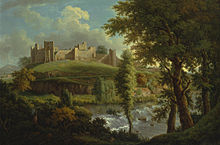Edmund Mortimer (rebel)
Edmund Mortimer IV | |
|---|---|
 Painting of the actor Junius Brutus Booth in costume as Edmund Mortimer (1823) | |
| Born | 10 December 1376[1] Ludlow Castle, Shropshire, England |
| Died | January 1409 (aged 32)[2] Harlech Castle, Wales |
| Family | Mortimer |
| Spouse | Catrin ferch Owain Glyndŵr (1402) |
| Father | Edmund Mortimer, 3rd Earl of March |
| Mother | Philippa, 5th Countess of Ulster |

Sir Edmund Mortimer IV (10 December 1376 – January 1409) was an English nobleman and landowner who played a part in the rebellions of the Welsh leader
Family

Edmund IV was born on 10 December 1376 at
Edmund Mortimer had an elder brother,
Edmund was financially well provided for, both by his father, who died when Edmund was 5 years old, and by his elder brother Roger.[3]
Edmund was a supporter of his cousin, Henry Bolingbroke,
When his elder brother Roger was slain in a skirmish at Kells in Ireland on 20 July 1398,[4] Edmund became responsible for protecting the interests of Roger's young son, Edmund Mortimer, 5th Earl of March, who also had a claim to the throne as heir to his father.[3]
Capture by Owain Glyndŵr

Both Edmund Mortimer and his brother-in-law Henry 'Hotspur' Percy fought for Henry IV against the Welsh rebel leader Owain Glyndŵr. However, at the Battle of Bryn Glas on 22 June 1402, Mortimer was defeated, allegedly because some of his Welsh forces defected, and he was taken prisoner.[3]
King Henry's suspicions were fuelled by rumours that Mortimer had fallen into captivity by his own design. He forbade the Percys to seek their kinsman's ransom, and by October 1402 began seizing Mortimer's estates, plate and jewels. Mortimer thereupon transferred his allegiance to
In the summer of 1403, the Percys rebelled and took up arms against the king. According to J. M. W. Bean, it is clear that the Percys were in collusion with Glyndŵr. Mortimer's brother-in-law Henry 'Hotspur' Percy and Hotspur's uncle, Thomas Percy, 1st Earl of Worcester, moved south with their army. However, Hotspur's father, Henry Percy, 1st Earl of Northumberland, was, for reasons never fully explained, slow to move south with his army. Hotspur and Worcester met Henry IV's forces at the Battle of Shrewsbury on 21 July 1403 without Northumberland's assistance. They were defeated; Hotspur was slain, and Worcester was executed two days later.[6]
The alliance of Glyndŵr and Edmund Mortimer with the
However, after Shrewsbury, Glyndŵr's attacks on the king's forces were largely unsuccessful, and according to T. F. Tout, "Mortimer himself was reduced to great distress". He died in 1409, either during or shortly after the eight-month siege of Glyndŵr's stronghold of Harlech Castle by Henry IV's son, Henry, Prince of Wales.[3]
Edmund Mortimer and his wife Catrin had one son, Lionel, and three daughters. After Mortimer's death, the king had Catrin and her daughters brought to London, where they were held in custody. In 1413 she and two of her daughters were buried at St Swithin, London Stone.[4]
Shakespeare and Sir Edmund Mortimer
Events in the life of Sir Edmund Mortimer were dramatised by Shakespeare in Henry IV, Part 1 (c. 1597). In the play, Shakespeare accurately identifies him as Hotspur's brother-in-law, but simultaneously conflates him with his nephew by referring to him as "Earl of March". He was famously played by Junius Brutus Booth, who was John Wilkes Booth’s father.
Ancestry
| Ancestors of Edmund Mortimer (rebel) | |||||||||||||||||||||||||||||||||||||||||||||||||||||||||||||||||||||||||||||||||||||||||||||||||||||||||||||||||||||||||||||||||||||||||||
|---|---|---|---|---|---|---|---|---|---|---|---|---|---|---|---|---|---|---|---|---|---|---|---|---|---|---|---|---|---|---|---|---|---|---|---|---|---|---|---|---|---|---|---|---|---|---|---|---|---|---|---|---|---|---|---|---|---|---|---|---|---|---|---|---|---|---|---|---|---|---|---|---|---|---|---|---|---|---|---|---|---|---|---|---|---|---|---|---|---|---|---|---|---|---|---|---|---|---|---|---|---|---|---|---|---|---|---|---|---|---|---|---|---|---|---|---|---|---|---|---|---|---|---|---|---|---|---|---|---|---|---|---|---|---|---|---|---|---|---|
| |||||||||||||||||||||||||||||||||||||||||||||||||||||||||||||||||||||||||||||||||||||||||||||||||||||||||||||||||||||||||||||||||||||||||||
Family connections
| |||||||||||||||||||||||||||||||||||||||||||||||||||||||||||||||||||||||||||||||||||||||||||||||||||||||||||||||||||||||||||||||||||||||||||||||||||||||||||||||||||||||||||||||||||||||||||||||||||||||||||||||||||||||||||||||||||||||||||||||||||||||||||||||||||||||||||||||||||||||||||||||||||||||||||||||||||||||||||||||||||||||||||||||||||||||||||||||||||||
| Notes | |||||||||||||||||||||||||||||||||||||||||||||||||||||||||||||||||||||||||||||||||||||||||||||||||||||||||||||||||||||||||||||||||||||||||||||||||||||||||||||||||||||||||||||||||||||||||||||||||||||||||||||||||||||||||||||||||||||||||||||||||||||||||||||||||||||||||||||||||||||||||||||||||||||||||||||||||||||||||||||||||||||||||||||||||||||||||||||||||||||
Notes
- Toutgive his date of birth as 9 November 1376.
- ^ Richardson III 2011, p. 195.
- ^ a b c d e f g h Tout & Davies 2004.
- ^ a b c Richardson III 2011, p. 195.
- ^ Cokayne 1932, p. 448; Richardson II 2011, pp. 190–1; Richardson III 2011, pp. 193–5, 307, 335, 341; Holmes 2004; Tout & Davies 2004.
- ^ Bean 2004.
- ^ a b Davies 2004.
- ^ a b c Holmes 2004.
- ^ a b c d Weir 2008, p. 96.
- ^ a b c d e Mortimer 2003, p. 319.
- ^ a b Weir 2008, pp. 95–6.
- ^ Mortimer 2003, p. 113.
- ^ a b Weir 2008, p. 92.
- ^ a b Weir 2008, p. 93.
- ^ a b Weir 2008, pp. 75–9.
References
- Bean, J.M.W. (2004). "Percy, Henry, first earl of Northumberland (1341–1408)". doi:10.1093/ref:odnb/21932. (Subscription or UK public library membershiprequired.)
- Burke, B. (1883). Burke's Dormant & Extinct Peerages. London: Harrison.
- Cokayne, G. (1932). H.A. Doubleday (ed.). The Complete Peerage. Vol. 8 (2nd ed.). London: St. Catherine Press. pp. 445–453.
- doi:10.1093/ref:odnb/19342. (Subscription or UK public library membershiprequired.)
- ISBN 0-312-34941-6.
- ISBN 978-1449966386.)
{{cite book}}: CS1 maint: location missing publisher (link - Richardson, D. (2011). Kimball G. Everingham (ed.). Magna Carta Ancestry. Vol. 3 (2nd ed.). Salt Lake City. ISBN 978-1-4499-6639-3.)
{{cite book}}: CS1 maint: location missing publisher (link - doi:10.1093/ref:odnb/19343. Archived from the original on 16 February 2019. (Subscription or UK public library membershiprequired.)
- ISBN 978-0-09-953973-5.
Further reading
- Davies, R.R. (2004). "Mortimer, Roger (VII), fourth earl of March and sixth earl of Ulster (1374–1398)". doi:10.1093/ref:odnb/19356. (Subscription or UK public library membershiprequired.)
- Tout, T. (1894). . In Lee, Sidney (ed.). Dictionary of National Biography. Vol. 39. London: Smith, Elder & Co.
- Walker, Simon (2004). "Percy, Sir Henry (1364–1403)". doi:10.1093/ref:odnb/21931. (Subscription or UK public library membershiprequired.)
